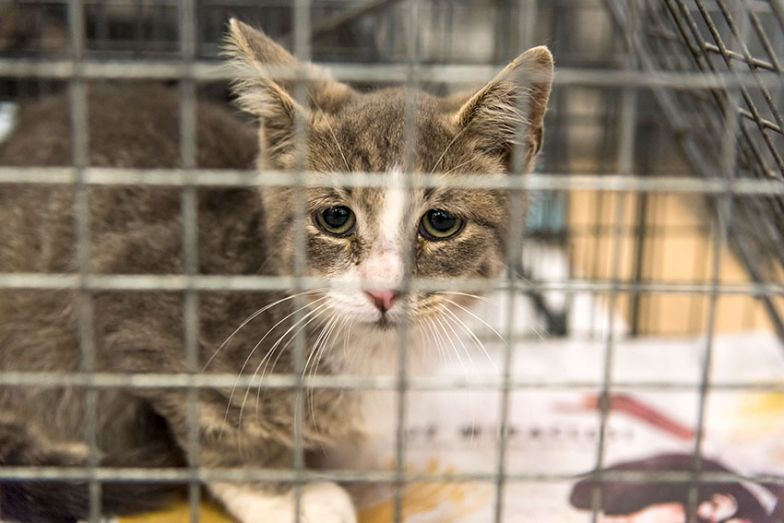One cute little stray cat shows up. You feed it. Now there are several cats. They have kittens. But before these kittens are even weaned the mama gets pregnant again. Within five months or so the first litter begins to procreate.
In less than a year, that one stray cat turns into 25. The neighbors are angry and you are overwhelmed. If you own a business that serves or sells food, your customers are wondering why you aren’t doing something about a situation that makes them feel uncomfortable.
So you call the shelters or animal control — and they don’t have space either, with few options other than euthanasia.
Welcome to Canyon Lake, where March is actually the pre-kitten season in a community already drowning in hundreds of unloved, unwanted cats.
Right now, most females are in heat or already are pregnant. By April, experts say phones will explode into action once more, with dozens of desperate citizens trying to do something about the kittens in their front yard.
Stop It Now
The situation may be out of control, but the solution isn’t out of reach, according to Bulverde resident Jenny Burgess, founder of Animal Rescue Connections (.org) in Bulverde.
“The biggest thing people need to understand is that this is a community problem and it has to be solved by the community,” she says. “Our little band of volunteers is not going to hack it. People need support, and they need to know there are resources available that are affordable. It is not hard at all. But the questions that people ask stop them from going ahead and doing anything.”
“Letting nature take its course leads to misery for the cat,” she says. “If kittens all survive, there’s a tragedy to that. Most of these kittens are born to die. Is that really what we should be allowing? They’re fodder for coyotes, hawks, disease and fire ants. And it’s not just kittens. Adult male cats are programmed to fight each other. They have horrific fights, deep wounds and so on. The females are destined to be either set upon by males, and they’re probably undernourished and fighting to feed their kittens while fighting off males who want to get at their kittens and kill them.”
Trap-Neuter-Release
The best, and most-humane solution for both cats and humans is to trap the felines, vet them, and return or set them loose again in the communities they came from, Burgess said.
Burgess learned the hard way. The graphic designer is one of four people who founded a wildly successful TNR cat-rescue program in San Antonio in 2004 after she and a neighbor tried to catch stray cats and find homes for them.
“That’s the admirable thing to do, but we realized we were not going to adopt our way out of this problem,” she says. “We realized we’ve got to stop kittens from being born.”
The British native, who’s lived in Comal County for over 20 years, was already familiar with TNR. It’s been used by rescuers and government agencies around the world for the last 50 years.
But laws in San Antonio in 2004 precluded TNR. Anyone who fed a cat had to accept legal responsibility for that animal. Burgess and her small army of cat rescuers soon were forced to skulk around like the felines they were trying to trap.
When San Antonio changed its animal codes in 2007 and endorsed TNR, volunteers came out of the woodwork.
“We never imagined that it would take off like it has done,” she said.
How It Works
So take a deep breath, Canyon Lake. Tension is always palpable, she says, as would-be, well-meaning, but flummoxed rescuers arrive for her classes or call for help.
“By the time you do the class you can almost feel the stress lifting, and people are saying they wish they had known about TNR before. The neighbors will say, ‘stop feeding and they’ll go away.’ No, they don’t. You just have starving animals. The answer is to control it and we are intelligent enough to be able to do that. There’s a method.”
TNR works because it factors in the territorial nature of cats, which are hard-wired to defend their territories from other felines (Burgess avoids the term “feral” due to its negative connotation).
Cats who are removed from the areas where they live and dumped elsewhere — or worse — are soon replaced by other un-neutered cats who quickly move into the now-empty neighborhoods. The cycle quickly repeats itself in a phenomenon known to rescuers as “the vacuum effect.”
However, cats who are trapped, neutered, then released back into their natural territories keep these other cats away. Over time, the cat population in a particular cat colony stabilizes then dwindles naturally.
Can You Help?
 Of course, none of this is cheap.
Of course, none of this is cheap.
“Most cats have other issues when we bring them in,” Burgess says.
The group doesn’t use traps found at feed stores, favoring more expensive ones that are safer and more reliable. Low-cost spay/neuter veterinary services help keep costs down, but there are other costs. It takes gas to drive all of these cats around. They also require rabies shots, wormer and flea control.
Sometimes kitties need surgery to fix wounds or treatment for other underlying medical issues. Cats in some colonies transmit genetic problems like ingrown eyelashes from litter to litter. These cats require additional surgery. And all cats need at least a day or so to recover from surgery before they can be released into the wild.
And while under anesthesia at the vet’s, the top half of each cat’s ear is clipped so animal control and others know they don’t need to be picked up.
Start Small
Burgess stresses people should not attempt TNR without proper training. Even cats who seem friendly on the front porch will bite and scratch out of fear when trapped.
“You can’t be cavalier,” she warns. “You can be hurt by a frightened cat.”
And one more thing, she said. Those cats outside your window are no different than the fat felines who purr on the back of your couch or drape themselves regally across your lap.
They just need a chance.
“We just got in our first kittens of the season, a feral mama and newborns,” Humane Society of New Braunfels (HSNBA) posted on Facebook today. “They are going out to a foster home today (yay!). However, we wanted to get a head start on finding more kitten foster homes since we are in the calm before the storm right now. There are so many benefits to fostering, including the joy of having cute, cuddly kittens around nonstop.”
To help, visit AnimalRescueConnections.org or email Burgess at animalrescueconnections@gmail.com.
For more information about trapping feral cats, contact Comal County Animal Control at 830-608-2016, HSNBA at 830-629-5287, or New Braunfels Community Cat Coalition (for ferals) at info@nbcats.org.
(Editor’s Note: Parts of this story originally appeared in MyCanyonLake.com in March 2018. If you are a cat rescue and would like to share your contact information or ideas, please email info@mycanyonlake.com.)





I did this and now the town is going to trap them and they will be killed at shelter rescue fixed them released back and now they are going to die one died in cage and four died at shelter all fixed and I’m pissed
Hi there very times I go and to being. Cat or kitten to the pond they have a problem so they make me feel bad I got take care of them back again and I tried and got to many of them.
If you are in Guadalupe or Comal Counties, it is free to spay and neuter any feral (wild) cats through the New Braunfels Community Cat Coalition. If you are a trapper in Comal or Guadalupe Counties and want to learn more about how our program works and making a reservation, visit https://www.nbcats.org/how-it-works/
Correction: I was one of 4 people who founded San Antonio Feral Cat Coalition in 2004. It’s continuing success is due to the efforts of hundreds of dedicated people who have got on board since then.
I also founded Animal Rescue Connections in Bulverde at the same time but devoted more time initially to developing the SA program where there was such a huge need. Amazing, hardworking folks joined the work and the SA program took on a life of its own.
I have learned so much from many skilled volunteers and my heart will always remain with SAFCC but my focus is now turned more towards Comal County, where I live and have met other dedicated folks who have joined Animal Rescue Connections in the effort to improve the lives of the outdoor cats in our area.